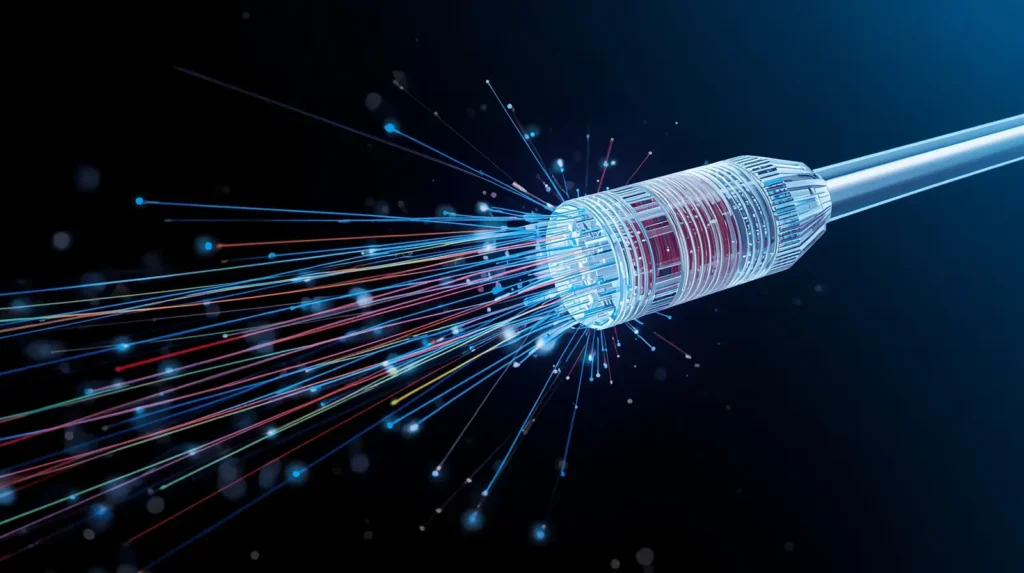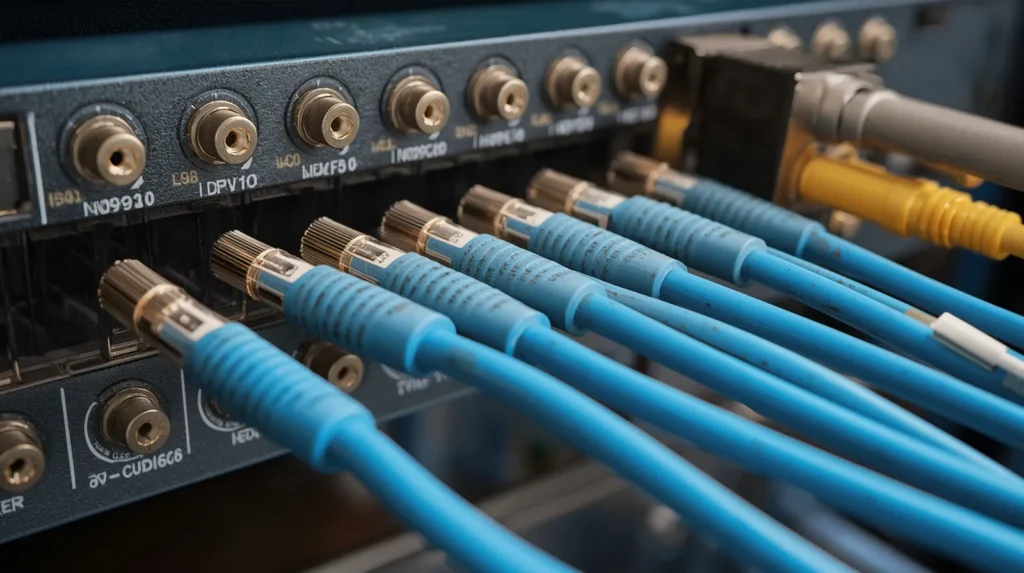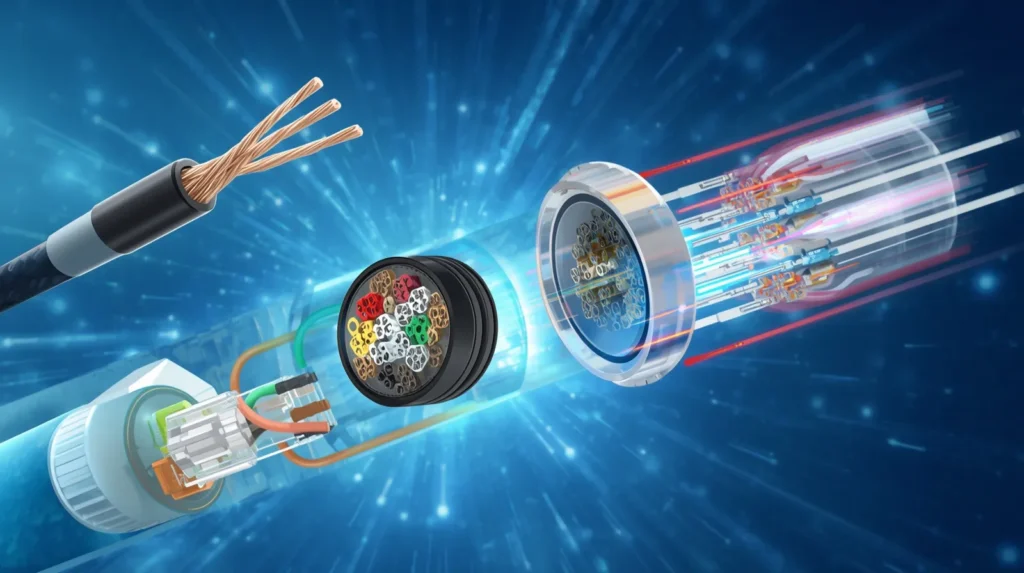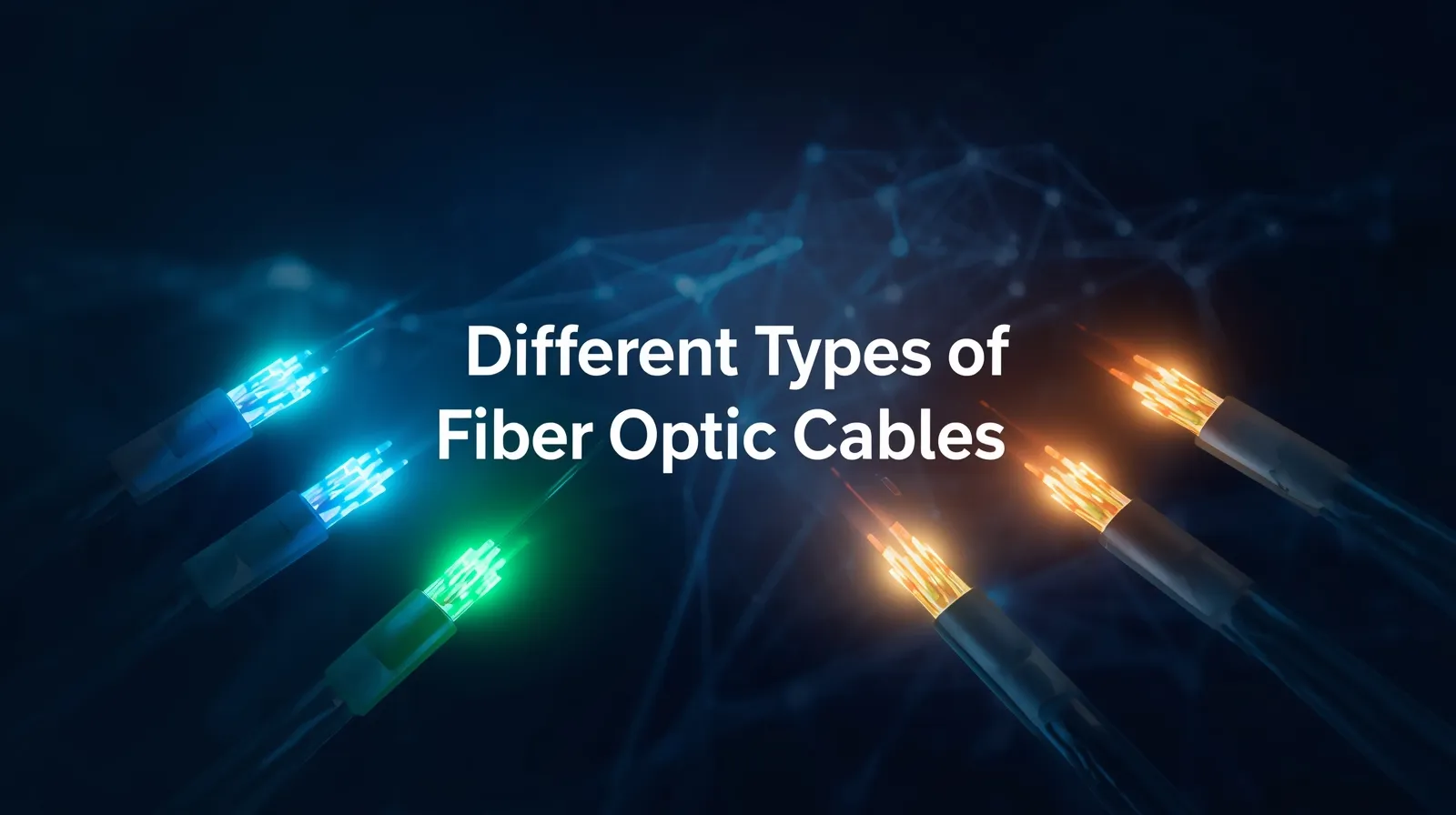Fiber optic technology has changed how the world connects. It carries data faster, more reliably, and over longer distances than traditional cable types. This article explains the different types fiber optic cables, how they compare to coaxial and twisted pair cables, and how to choose the right one for your network. By the end, you will clearly understand which type best fits your communication needs and why fiber optics remain the top choice for modern infrastructure.
Understanding Modern Communication Cables
Every digital connection, from the internet at home to large office networks, depends on communication cables. These cables are the invisible pathways that carry data between computers, phones, and devices. Over time, engineers have developed several kinds of cables to meet growing speed and reliability needs.
The most common types of communication cables include fiber optic, coaxial, and twisted pair cables. Each has its own purpose and structure. Twisted pair cables, for example, have been used in telephone wiring and local area networks. Coaxial cables are often found in cable TV setups and early broadband systems. But the star of modern communication is the fiber optic cable, which uses light instead of electrical signals to transfer data.
What Is a Fiber Optic Cable and How Does It Work?

A fiber optic cable is made from strands of glass or plastic thinner than a human hair. These tiny fibers transmit data as pulses of light instead of electrical signals. The light travels through the fiber’s core, bouncing off the inner walls due to a special reflective layer called cladding. This design keeps the light signals inside, even when the cable bends slightly.
Because light can travel so quickly and with minimal loss, fiber optic cables can send huge amounts of data over long distances with incredible accuracy. Unlike copper cables, which can experience interference or signal loss, fiber optics provide clean, fast, and consistent performance.
The fiber optic cable definition can be summed up in simple terms a thin, light-carrying cable used to transmit information at lightning speed. It’s the backbone of today’s internet, phone systems, and high-speed data networks.
Difference Between Fiber Optic and Coaxial Cable
Although both fiber optic and coaxial cables are used for data transfer, they work in completely different ways. The key difference between fiber optic and coaxial cable lies in how they carry data. Fiber uses light, while coaxial uses electricity.
Coaxial cables have a copper core surrounded by insulation, a metal shield, and an outer plastic layer. They’re designed to protect the signal from interference but still face limits on how far and how fast data can travel. In contrast, fiber optic cables can carry data across continents with almost no signal loss.
To put it simply, if coaxial cables are like highways with cars, then fiber optic cables are high-speed bullet trains faster, smoother, and more efficient.
Coaxial Cable vs Fiber Optic: Which Performs Better?

When comparing coaxial cable vs fiber optic, performance is where fiber clearly wins. Fiber cables offer far higher bandwidth and faster transmission speed. Coaxial cables, although strong and reliable, can’t handle the same data load.
The bandwidth of coaxial cable is limited by its electrical design. It’s great for home television systems but can struggle with modern broadband speeds. On the other hand, fiber optic cables can handle multiple data streams at once, making them ideal for cloud services, online gaming, and large business networks.
Still, coaxial cables aren’t useless. They remain cost-effective for shorter distances and lower-speed applications. Many older buildings still use coaxial lines because upgrading can be expensive. Yet, more people are switching to fiber as demand for faster internet grows.
Fiber Optic vs Coax Internet: What You Need to Know
If you’re wondering which internet type is better, fiber optic vs coax internet, the answer depends on your needs. Coax internet can deliver decent speeds for basic use, but fiber optic internet offers the fastest, most stable connection.
Fiber optics don’t slow down during peak hours, while coaxial networks often do. With fiber, you can stream, game, and upload large files at the same time without lag. Businesses that rely on cloud storage or video conferencing benefit most from fiber because it ensures smooth, real-time communication.
In short, fiber delivers the future of connectivity, while coax still serves as a stepping stone for older systems transitioning toward it.
Coaxial and Twisted Pair Cables: How They Fit in Communication Networks
Both coaxial and twisted pair cables have been essential in the growth of telecommunication networks. A twisted pair cable consists of two copper wires twisted around each other to reduce electromagnetic interference. These are still used in telephone lines and Ethernet connections.
Coaxial cables are better shielded than twisted pairs, giving them a performance advantage for longer distances. However, they are bulkier and harder to install. Both of these cable types paved the way for modern networking, even though fiber optics now dominate large-scale data systems.
In simple terms, twisted pair and coaxial cables laid the groundwork for the digital world we know today, but fiber optics took it to the next level.
Types of Communication Cables Used in Network Systems

Today’s communication systems use three main cable types: twisted pair, coaxial, and fiber optic. Twisted pair cables are common in home networks and telephones. Coaxial cables are mostly used in cable TV and broadband connections. Fiber optic cables are used for high-speed internet, backbone connections, and data centers.
Each cable type has strengths. For instance:
- Twisted pair cables are flexible and affordable.
- Coaxial cables are strong and good for medium-distance data transfer.
- Fiber optic cables offer unmatched speed and reliability.
When engineers design communication systems, they often combine these types depending on cost, distance, and performance requirements. That balance makes modern networks both affordable and efficient.
Different Types of Fiber Optic Cables Explained
Now we reach the core of this topic understanding the different types fiber optic cables available today. Fiber optics come in three main varieties, each built for specific uses:
a. Single-Mode Fiber (SMF)
Single-mode fiber has a small core, allowing light to travel in a straight path. It’s perfect for long-distance communication because it minimizes signal distortion. You’ll find single-mode fiber in undersea cables, national backbones, and large enterprise systems.
b. Multi-Mode Fiber (MMF)
Multi-mode fiber has a larger core, allowing multiple light signals to travel at once. It’s designed for shorter distances, such as inside buildings or campuses. MMF is more affordable and easier to install, making it popular for internal network setups.
c. Plastic Optical Fiber (POF)
Plastic optical fiber uses polymer materials instead of glass. It’s not as fast or durable as SMF or MMF but offers flexibility and lower costs. POF is often used in automotive networks, home theaters, and short-range communication.
Each of these fiber optic types offers unique benefits. When selecting one, consider the distance, speed, and environment where it will be used.
Transmission Speed and Bandwidth of Coaxial vs Fiber Cables
When comparing transmission speed of coaxial cable with fiber optic cables, the difference is dramatic. Coaxial cables can handle speeds up to a few gigabits per second, depending on quality and distance. However, fiber optics can support terabit speeds, which is thousands of times faster.
The coaxial cable maximum speed is limited by its copper construction and electrical interference. In contrast, light in fiber travels with minimal resistance. This is why fiber networks remain consistent, even over long distances.
Moreover, fiber optics offer a huge advantage in bandwidth. With fiber, multiple data streams can move at once without slowing each other down. For heavy internet users or companies running multiple servers, this makes all the difference.
Select the Right Fiber Optic Line for Your Network
When choosing a fiber optic solution, it’s essential to understand your environment. If you’re connecting distant offices or buildings, single-mode fiber is the best choice. For shorter, in-house networks, multi-mode fiber works perfectly.
Before installing, evaluate:
- Distance how far the signal needs to travel.
- Bandwidth needs how much data you’ll transmit.
- Budget balance cost with long-term reliability.
- Durability some fibers resist bending or temperature changes better than others.
A fiber-optic cable that consists of two cables is often used for duplex communication sending and receiving data at the same time. For most modern networks, this setup improves efficiency and reduces signal delay.
Partnering with professionals like Heritage Cabling ensures your fiber system is installed correctly, tested, and maintained for years of smooth performance.
Professional Fiber Optic Cabling Services in Dallas, TX by Heritage Cabling
Setting up fiber optic infrastructure is not a do-it-yourself project. It requires precision, experience, and the right tools. That’s why partnering with experts makes a big difference. Heritage Cabling has years of experience installing and maintaining fiber optic systems for both residential and commercial clients.
From data centers to small offices, the company helps you select the right types of communication cable and ensures clean, secure connections. Whether upgrading from coaxial systems or building a new network, their professional service guarantees long-term reliability and top-tier performance.
With the growing demand for faster internet and seamless connectivity, fiber optics have become essential. If you want your network to perform at its best, choosing the right cable and the right installer is key.
When you’re ready to upgrade your cabling system or explore fiber optic vs coax internet options, reach out to professionals who understand the details. Contact Heritage Cabling today for expert advice and installation support that fits your needs and your budget.




